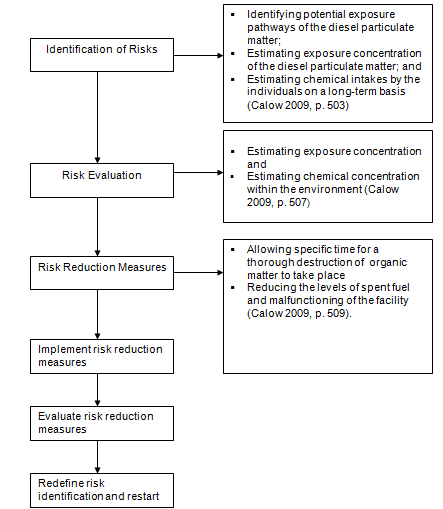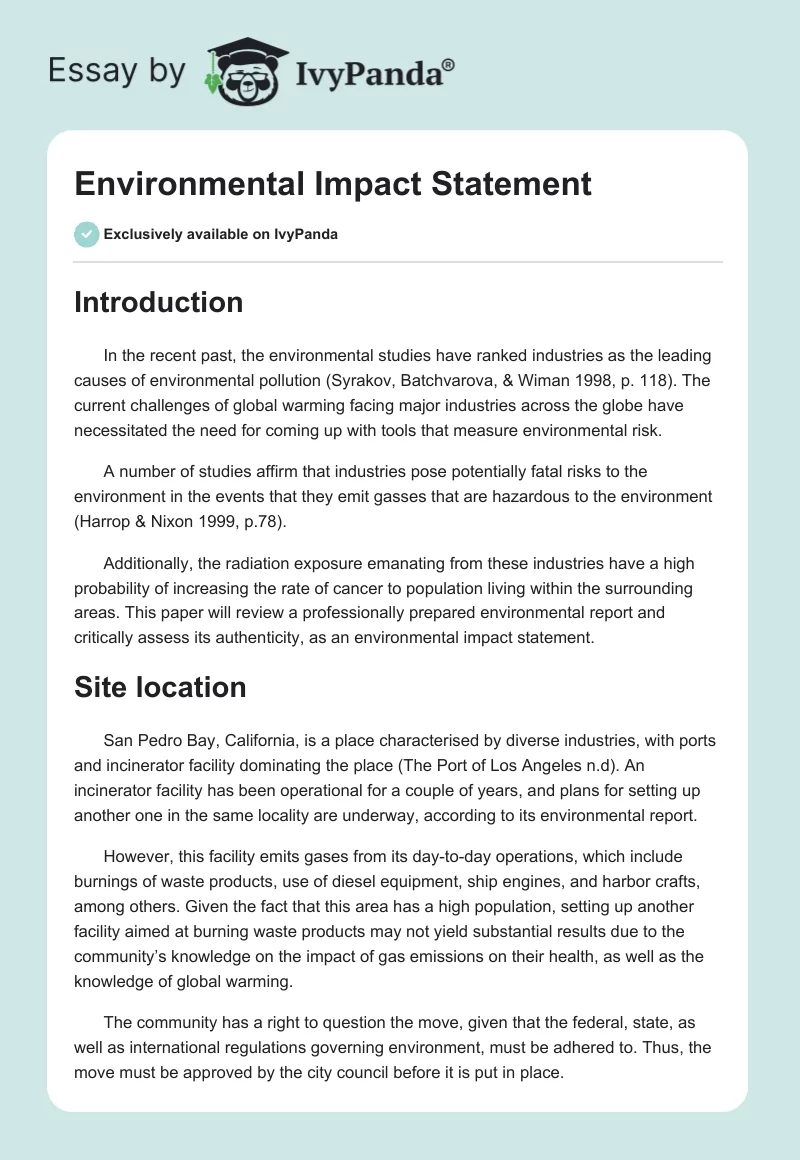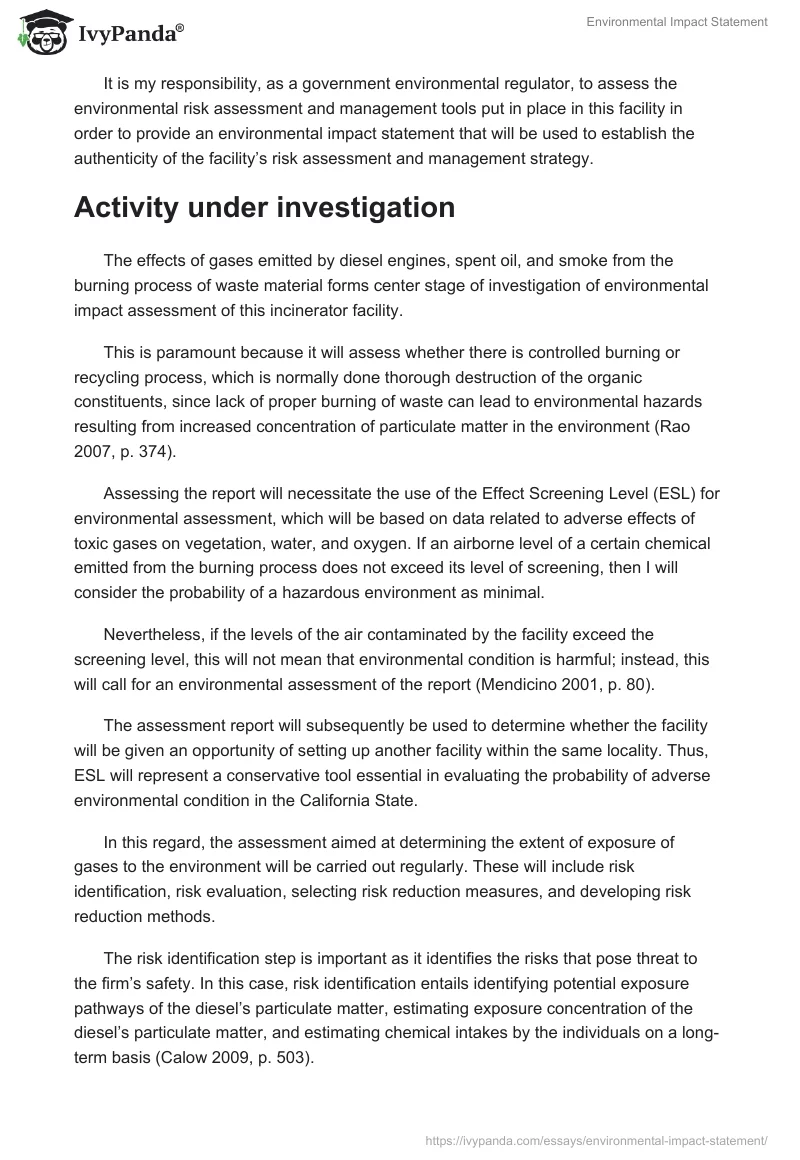Introduction
In the recent past, the environmental studies have ranked industries as the leading causes of environmental pollution (Syrakov, Batchvarova, & Wiman 1998, p. 118). The current challenges of global warming facing major industries across the globe have necessitated the need for coming up with tools that measure environmental risk.
A number of studies affirm that industries pose potentially fatal risks to the environment in the events that they emit gasses that are hazardous to the environment (Harrop & Nixon 1999, p.78).
Additionally, the radiation exposure emanating from these industries have a high probability of increasing the rate of cancer to population living within the surrounding areas. This paper will review a professionally prepared environmental report and critically assess its authenticity, as an environmental impact statement.
Site location
San Pedro Bay, California, is a place characterised by diverse industries, with ports and incinerator facility dominating the place (The Port of Los Angeles n.d). An incinerator facility has been operational for a couple of years, and plans for setting up another one in the same locality are underway, according to its environmental report.
However, this facility emits gases from its day-to-day operations, which include burnings of waste products, use of diesel equipment, ship engines, and harbor crafts, among others. Given the fact that this area has a high population, setting up another facility aimed at burning waste products may not yield substantial results due to the community’s knowledge on the impact of gas emissions on their health, as well as the knowledge of global warming.
The community has a right to question the move, given that the federal, state, as well as international regulations governing environment, must be adhered to. Thus, the move must be approved by the city council before it is put in place.
It is my responsibility, as a government environmental regulator, to assess the environmental risk assessment and management tools put in place in this facility in order to provide an environmental impact statement that will be used to establish the authenticity of the facility’s risk assessment and management strategy.
Activity under investigation
The effects of gases emitted by diesel engines, spent oil, and smoke from the burning process of waste material forms center stage of investigation of environmental impact assessment of this incinerator facility.
This is paramount because it will assess whether there is controlled burning or recycling process, which is normally done thorough destruction of the organic constituents, since lack of proper burning of waste can lead to environmental hazards resulting from increased concentration of particulate matter in the environment (Rao 2007, p. 374).
Assessing the report will necessitate the use of the Effect Screening Level (ESL) for environmental assessment, which will be based on data related to adverse effects of toxic gases on vegetation, water, and oxygen. If an airborne level of a certain chemical emitted from the burning process does not exceed its level of screening, then I will consider the probability of a hazardous environment as minimal.
Nevertheless, if the levels of the air contaminated by the facility exceed the screening level, this will not mean that environmental condition is harmful; instead, this will call for an environmental assessment of the report (Mendicino 2001, p. 80).
The assessment report will subsequently be used to determine whether the facility will be given an opportunity of setting up another facility within the same locality. Thus, ESL will represent a conservative tool essential in evaluating the probability of adverse environmental condition in the California State.
In this regard, the assessment aimed at determining the extent of exposure of gases to the environment will be carried out regularly. These will include risk identification, risk evaluation, selecting risk reduction measures, and developing risk reduction methods.
The risk identification step is important as it identifies the risks that pose threat to the firm’s safety. In this case, risk identification entails identifying potential exposure pathways of the diesel’s particulate matter, estimating exposure concentration of the diesel’s particulate matter, and estimating chemical intakes by the individuals on a long-term basis (Calow 2009, p. 503).
Calow (2009, p.507) contends that risk evaluation step is normally divided into three categories: predictability, probability, and severity. Probability could be termed as a high possibility of an event.
Toxic gas exposure within the environment is an example of highly probable event. One can only predict the outcome when he is able to foresee the possibility of an unforeseen risk at before the actual incident occurs, taking into account the outcome of the menace.
The other step involves selecting risk reduction measures, which entails risk avoidance, and it can be achieved by eliminating risk-causing factors (Calow 2009, p. 509). In risk acceptance, the risk cannot be effectively eliminated, or it would not be cost-effective to do so.
For case in point, a little leaking could be allowed if its outcome would not cause severe effects on the environment that calls for highly costly measures.
Calow (2009, p. 512) points out the last step as developing risk reduction methods strategy by taking into consideration of the time required, the cost of developing the strategy, as well as the material necessary to implement viable the risk elimination plans. The last three steps involve the implementation, evaluation, and reassessment of risk mitigation measures.
All the above steps are crucial while putting the environmental impact statement in place. This stems from the fact that they are in a position of helping the government environmental regulator understand the problem at hand and determine relevant and effective solutions.
As United States Environmental Protection Agency (n.d.) points out, a governing authority cannot authenticate a firm’s risk management process unless the firm comes up with a viable risk management strategy that is well understood. Thus, the flow diagram below facilitates a deep understanding of how the incinerator facility uses the environmental impact assessment

Regulation/ legislation
In order to create a positive opinion about a proper risk assessment of the expansion of the ports of Los Angeles and Long Beach located in the San Pedro Bay, the assessment must be assessed in line with the zonal legislation through the agencies. These agencies have regulations that aim at reducing the risk associated with expansion of the ports of Los Angeles and Long Beach located in the San Pedro Bay, California.
The California Environmental protection Agency (Cal/EPA) serves as one of the agencies that represent the efforts of the basic components of the state from exposure of particulate matter to environmental protection. Specifically, this body is mandated to guarantee a clear judgment about the uncertainties of the environmental exposure using stipulated guidelines.
It ensures that the environmental impact assessment is based on scientific and mathematical model (The Port of Los Angeles n.d). As such, the body determines the legality of an environmental report of a given firm by assessing statistical data, which quantifies the risks involved through probability ranges and risk exposure.
Background
As a government environmental regulator, I took the approach of recording environmental condition of the area on a unique dimension, since diesel engine, ship engines, and harbor crafts are not the only source of particulate matter and air pollutants around the port and around the area of California.
Thus, I estimated the exposure concentration by measuring and ranking them according to the level of adverse effects on the environment on both short and long-term basis. This was successfully achieved by breaking down every emission in the facility, which includes the emissions from the diesel engine/ ship engines, spent fuel, and smoke, and I subsequently identified the potential exposure pathways of the each one of them.
Moreover, it was paramount to consult on activities within the community that have a direct impact on the environment in an effort to distinguish between the environmental pollution emanating from the facility and the environmental pollution emanating from activities carried out by the members of the community, including smoking tobacco, diesel engines, and spent fuel.
In my investigation I found out that despite the awareness of the negative side effects of smoking in relation to the environment, a considerable number of members of the community engage in smoking behavior, thereby increasing the level of environmental pollution. More so, vehicles that consume large amount of diesel escalate the environmental pollution within the community, as the table below demonstrates:
Assessment protocol
This stage hold the ultimate responsibility of ensuring that the risk management and assessment are carried out in a viable manner that takes into account a number of functions.
This includes identifying the critical applications prone to environmental risk, quantifying the potential impact of environmental risk, detailing the escalation process of environmental risk and implementing them in time to avert environmental disaster(Harrop & Nixon 1999, p. 78).
The table below is a clear indication of general aspects of risks that need to be accurately identified at the onset of operations to guide in assessing whether the firm has taken the required risk mitigation strategy. The table gives categorisations that are explained in detail in the section that follows:
Risks
This section involves a careful analysis of the problem at hand. It clearly defines what environmental risk entails. It came to my knowledge that the incinerator facility has the potential of causing environmental risk in diverse stages.
It is apparent that the smoke emanating from the diesel engine causes environmental pollution as it forms into particulate manner within the atmosphere. High levels of particulate matter within the environment may expose the environment to global warming (Liao 2008. p. 103).
More so, the environmental risk may emanate from malfunctioning of the incinerator facility, and this can create a disastrous situation characterised by widespread effects. Checks for malfunction, therefore, necessitate coming up with high levels of expertise from a wide range of knowledge, who would ensure an adequate eradication of the predicament of toxic gasses (Sullivan & Wyndham 2001, p. 15).
The spent fuel in the incinerator facility can cause environmental pollution if measures are not put in place to control the exposure pathways. Additionally, spent fuel has a link to the environment degradation since fuel assemblies are stored underwater, and they continue to produce emissions, which may have negative impact on the environment (Harrop & Nixon 1999, p. 79).
Probability
This refers to a circumstance that could not happen by chance; the ranges in the matrix are interpreted as follows:
The probability rating is determined by considering a wide range of factors using scientific methods.
Risk Impact
Risk impact can best be defined using the table below:
Risk exposure
In this matrix, the risk exposure is calculated by getting the product of probability and occurrence impact. The definitions of the categories are as follows:
- Low risk: In this case, the environmental exposure to risk is at minimal, and therefore not alarming to environmental pollution.
- Moderate risk: In this case, the environmentalist should adopt a strategy of ensuring that the risk does not escalate to higher levels.
- High risk: this is an indication that there is adverse environmental pollution within the vicinity, which requires immediate attention. This level necessitates high environmental pollution control strategies (Harrop & Nixon 1999, p. 80).
Impact Time Frame
Two dates should be put on notice while assessing the impact time frame: one is the date that the risk effects could be experienced, while the second one is the latest date that the risk effects could be experienced (Harrop & Nixon 1999, p. 80).
The two dates are of paramount importance in determining when the mitigation efforts should be put in place and the time in which they should be withdrawn, that is, when the expected risk is passed by events.
Findings
Compliance issues
The Resource Conservative and recovery Act (RCRA), section 3005 of the United States Environmental Protection Agency, require the Environmental Protection Agency (EPA) to establish permitting requirements applicable to hazardous waste, treatment, storage as well as disposal facilities.
The respondents have a responsibility of submitting the information that has a sole purpose of either first permit application or for a revised permit application.
The owners of the incinerator facility are subject to permits for new facilities that are not yet constructed as well as permits for facilities that have newly regulated units and interim status facilities. EPA uses the information contained in the permit to identify the persons who are legally responsible for hazardous waste activities within the community, and they use this to determine the facilities that require permits under more than one program.
EPA also assesses whether there is any possibility of polluting the nearby ground and surface waters, since some chemical are drained under the sea. More so, it determines the specific waste that a firm is legally allowed to handle, and it ensures that risk management program is implemented by the facility (United States Environmental Protection Agency n.d.).
With this in mind, I found out that the incinerator facility environmental report complies with the legislature because, despite the fact that it already has a running facility that has a license, it endeavors to assess the environmental impact of establishing another facility within the same locality.
More so, compliance with environmental issue is evidenced by the fact that it engages all the stakeholders and its risk management strategy is congruent with the expectations of the community.
Assumptions Made
The environmental assessment of incinerator facility is aimed at identifying potential exposure pathways of the diesel particulate matter, spent fuel, and smoke from the facility. However, this cannot be achieved without making an assumption. One of the assumptions is derived from the fact that diesel engines are not the only source of particulate matter and air pollutant around the port and around the area of California.
Therefore, it becomes a challenge while measuring the exposure that distinguishes the potential environmental risk caused by facility from other air pollutants emanating from the community members within the environs of California. This has created an avenue for making some assumption with regard to particulate matter emanating from diesel engine, spent fuel and smoke.
This stems from the fact that, even though the environmentalists are able to identify the exposure pathways, some of the particulate matters from the facility have a tendency of mixing with other gases within the environment and thus leaving the environmentalists with no option.
Effectiveness of the Environmental Impact Assessment
Even though the environmental impact assessment is able to give substantial results, the process is compounded with complexities, since it is vulnerable to some errors. For case in point, in the process of measuring the level of toxic gases emanating from the incinerator facility, the particulate matter might occasionally mix with types other gases, yielding to harmless gases within the environment.
More so, the meter might be subjected to measuring gases emanating from motor vehicles instead of toxic gases emanating from the incinerator facility, resulting in unsupported inference (Schwartz 2001, p. 4).
Nevertheless, errors emanating from such incidences can be contained by using a systematic approach that involves taking environmental measures at different time intervals for a longer period. Such an approach will ensure that the errors are minimised and that the measurements taken give room for a small margin of allowance for statistical error (Uyeda 2009, p. 41).
Consistency with industry Best Practice
The environmental impact statement of incinerator facility is consistent with the industry’s best practice because, through the assessment, it addresses environmental issues by helping the workers realise how the industry interacts with the ecosystem.
The industry’s mission is to eradicate waste in order to eradicate toxic gases emanating from the waste; therefore, carrying an assessment helps to ensure that it upholds its mission in a credible manner that does not end of escalating environmental pollution.
More so, involving the stakeholders and the community in the assessment is a clear indication that the assessment is within the industry’s best practice, as this shows that it is closely associated with the activities of the community.
Conclusion
The environmental risk assessment presented in this report provides an analysis of how environmental risk is managed at San Pedro Bay, California, and gives recommendation on how risk assessment and management can be handled effectively. This report provides an assessment of the incinerator facility, with a view of evaluating its authenticity with regard to environmental risk assessment and management.
The fact that this report has assessed and established the authenticity of the report makes it stand a chance of setting up another facility within the area. The viability of the report is evidenced by the fact that it provides risks assessment and management strategy through problem identification, as well as the factors that are correlated with it.
The tools then proceed to identify workable solutions associated with factors like the probability, impact, exposure level and timeline of the risk. Despite the challenges in the measurements, this environmental impact statement ensures that the environmental risks are effectively managed within the incinerator facility.
List of references
Calow, P 2009, Handbook of environmental risk assessment and management, John Wiley and Sons, Hoboken, NJ.
Harrop, D & Nixon, J 1999, Environmental assessment in practice, Routledge, London.
Liao, K-J 2008, Sensitivity and uncertainty analyses of impacts of climate change on regional air quality, Georgia Institute of Technology, Atlanta, Ga.
Mendicino, L 2001, Environmental issues with materials and processes for the electronics and semiconductor industries: Proceedings of the fourth international symposium, Electrochemical Society, Pennington, NJ.
Rao, C 2007, Environmental pollution control engineering, New Age International, New York.
Schwartz, S 2001, Quality assurance of exposure models for environmental risk assessment of substances. GRIN Verlag publishers, München.
Sullivan, R & Wyndham, H 2001, Effective environmental management: Principles and case studies, Allen & Unwin, St. Leonards, N.S.W.
Syrakov, D, Batchvarova, E, Wiman, B 1998, Long-range air pollution: From models to policies: proceedings from the Swedish-Bulgarian Workshop, 1997, Sozopol, Bulgaria, Pensoft, Sofia.
The Port of Los Angeles. n.d., Draft EIR – Southern California International Gateway (SCIG) Project. Web.
United States Environmental Protection Agency. n.d., Air Polution. Web.
Uyeda, C 2009, Australian master environment guide, CCH Australia, North Ryde, N.S.W.


